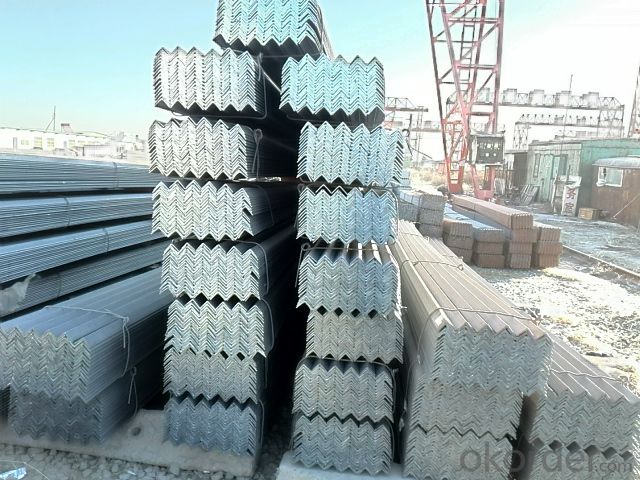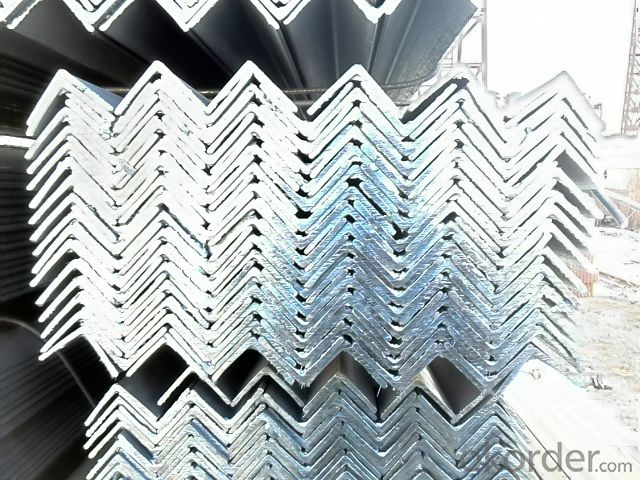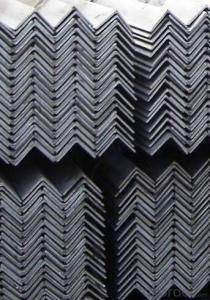Products Steel Angle Bar with High Quality
- Loading Port:
- Tianjin
- Payment Terms:
- TT or LC
- Min Order Qty:
- 25 m.t.
- Supply Capability:
- 20000 m.t./month
OKorder Service Pledge
OKorder Financial Service
You Might Also Like
Product Description:
OKorder is offering high quality Steel Angles at great prices with worldwide shipping. Our supplier is a world-class manufacturer of steel, with our products utilized the world over. OKorder annually supplies products to European, North American and Asian markets. We provide quotations within 24 hours of receiving an inquiry and guarantee competitive prices.
Product Applications:
Steel Angles are ideal for structural applications and are widely used in the construction of buildings and bridges, and the manufacturing, petrochemical, and transportation industries.
Product Advantages:
OKorder's Hot Rolled Steel Angles are durable, strong, and resist corrosion.
Main Product Features:
· Premium quality
· Prompt delivery & seaworthy packing (30 days after receiving deposit)
· Corrosion resistance
· Can be recycled and reused
· Mill test certification
· Professional Service
· Competitive pricing
Product Specifications:
Manufacture: Hot rolled
Grade: Q195 – 235
Certificates: ISO, SGS, BV, CIQ
Length: 6m – 12m, as per customer request
Packaging: Export packing, nude packing, bundled
Sizes: 25mm-250mm | ||
a*t | ||
25*2.5-4.0 | 70*6.0-9.0 | 130*9.0-15 |
30*2.5-6.6 | 75*6.0-9.0 | 140*10-14 |
36*3.0-5.0 | 80*5.0-10 | 150*10-20 |
38*2.3-6.0 | 90*7.0-10 | 160*10-16 |
40*3.0-5.0 | 100*6.0-12 | 175*12-15 |
45*4.0-6.0 | 110*8.0-10 | 180*12-18 |
50*4.0-6.0 | 120*6.0-15 | 200*14-25 |
60*4.0-8.0 | 125*8.0-14 | 250*25 |
FAQ:
Q1: Why buy Materials & Equipment from OKorder.com?
A1: All products offered byOKorder.com are carefully selected from China's most reliable manufacturing enterprises. Through its ISO certifications, OKorder.com adheres to the highest standards and a commitment to supply chain safety and customer satisfaction.
Q2: How do we guarantee the quality of our products?
A2: We have established an advanced quality management system which conducts strict quality tests at every step, from raw materials to the final product. At the same time, we provide extensive follow-up service assurances as required.
Q3: How soon can we receive the product after purchase?
A3: Within three days of placing an order, we will begin production. The specific shipping date is dependent upon international and government factors, but is typically 8 to 10 workdays.
Images:



- Q:Can steel angles be used for bracing?
- Certainly! Bracing can be achieved using steel angles. These angles are widely employed in construction and engineering ventures to furnish structural support and reinforcement. Their versatility allows for effortless welding or bolting, rendering them adaptable to diverse applications, including bracing. Owing to their inherent strength and rigidity, steel angles excel at bestowing stability and withstanding lateral forces. They are frequently utilized to brace columns, beams, and other structural components, thereby augmenting the overall robustness and stability of the edifice.
- Q:Can steel angles be used for pipe supports or hangers?
- Pipe supports or hangers can indeed utilize steel angles. These angles offer structural reinforcement and stability to pipes, rendering them appropriate for a wide range of construction and industrial applications. The L-shaped configuration of steel angles enables effortless attachment to walls, ceilings, or other structural components, establishing a robust foundation for suspending or supporting pipes. Moreover, the robustness and resilience of steel angles enable them to withstand the weight and pressure exerted by the pipes, ensuring enduring stability and dependability. In summary, steel angles are frequently employed and prove highly effective as pipe supports and hangers.
- Q:What are the different methods for reinforcing steel angles?
- There are several methods for reinforcing steel angles, including welding additional steel plates or bars to the angle to increase its strength and stability, using brackets or gussets to provide additional support, and using adhesive bonding agents or epoxy coatings to enhance the bond between the angle and the surrounding structure. These methods help to ensure that the steel angle can withstand higher loads and provide better resistance against bending or twisting forces.
- Q:Can steel angles be used for solar panel mounting?
- Solar panel mounting can indeed utilize steel angles. The utilization of steel angles in solar panel mounting systems is prevalent owing to their robustness, longevity, and adaptability. They furnish a stable and secure framework to bear the weight of the solar panels and endure environmental elements such as intense winds and substantial snow loads. Steel angles additionally facilitate effortless modification and positioning of the solar panels to optimize exposure to sunlight. Furthermore, steel angles can be readily tailored and manufactured to meet precise project specifications, rendering them a favored option within the solar sector.
- Q:What is the maximum length for a curved steel angle?
- The maximum length for a curved steel angle depends on several factors, including the diameter of the curve, the thickness of the steel, and the specific requirements of the project or application. In general, the length of a curved steel angle can vary from a few inches to several feet. However, it is important to consult with a structural engineer or a manufacturer to determine the maximum length that can be achieved without compromising the structural integrity of the angle. Additionally, the manufacturing process and equipment available may also play a role in determining the maximum length achievable for a curved steel angle.
- Q:Can steel angles be painted over?
- Indeed, painting over steel angles is possible. To ensure a successful outcome, it is vital to first guarantee that the surface is thoroughly cleansed and devoid of any dirt, oil, or rust. Accomplishing this can be done by utilizing a wire brush or sandpaper to eliminate any loose particles, followed by wiping the surface with a clean cloth. Once the surface is adequately prepared, it is necessary to apply a specialized primer created for metal surfaces in order to enhance adhesion and prevent corrosion. After the primer has dried, a suitable paint can be administered using a brush, roller, or spray gun. It is advisable to select paints specifically formulated for metal applications to ensure proper adhesion and durability. Over time, routine maintenance and repainting may be necessary to uphold the appearance and safeguard the steel angles from corrosion.
- Q:Can steel angles be used in cold-formed steel construction?
- Yes, steel angles can be used in cold-formed steel construction. They are commonly used as structural members in framing systems, providing support and stability to the overall structure. Steel angles are particularly useful in load-bearing walls, roof trusses, and floor systems, as they offer excellent strength and durability. Additionally, their versatility allows for various design possibilities in cold-formed steel construction.
- Q:How much is the weight of 40 * 3 angle steel theory?
- Angle called angle, the steel strip is perpendicular to each other on both sides into the corner. There are equal angles and unequal angles. The two sides of an equal angle steel are equal in width. The specifications are expressed in millimeters of edge width * edge width * edge thickness. Such as "/ 30 x 30 x 3", that is 30 mm width equal angle, edge thickness of 3 mm.
- Q:Can iron angle steel be welded with stainless steel angle steel?
- If the angle, in a cross-sectional angle welding of carbon steel plate, stainless steel angle welding a stainless steel cross sectional iron. Two cross cutting iron plate punching, 8.8 high strength screw fastening piece.Carbon steel and stainless steel welding, belong to dissimilar metal welding. Higher requirements for welding technology. Screw connections are the most economical,
- Q:What are the different types of connections used for steel angles in industrial applications?
- In industrial applications, steel angles are commonly used for various structural purposes, and therefore, different types of connections are employed to ensure their stability and strength. Some of the different types of connections used for steel angles in industrial applications include: 1. Welded Connections: Welding is a widely used method to connect steel angles in industrial applications. It involves melting the edges of two steel angles together and allowing them to solidify, creating a permanent and strong connection. Welded connections provide excellent strength and durability, making them suitable for heavy-duty applications. 2. Bolted Connections: Bolted connections involve using bolts and nuts to secure steel angles together. Holes are typically drilled into the angles, and bolts are inserted through these holes and tightened using nuts. Bolted connections offer the advantage of being easily dismantled and modified, making them suitable for applications where frequent adjustments or repairs are necessary. 3. Riveted Connections: Riveting is a traditional method of connecting steel angles, although it is less commonly used in modern industrial applications. Riveted connections involve inserting a rivet through holes in the steel angles and then deforming the rivet to secure the angles together. Although riveted connections provide good strength, they are time-consuming and require specialized equipment. 4. Clip Connections: Clip connections involve using metal clips or brackets to connect steel angles. These clips are typically bolted or welded to the steel angles, providing a secure connection. Clip connections are often used in applications where quick and easy assembly and disassembly are required, such as temporary structures. 5. Gusset Plate Connections: Gusset plates are thin steel plates that are used to connect steel angles in industrial applications. These plates are typically bolted or welded to the steel angles, providing additional strength and stability. Gusset plate connections are commonly used in applications where higher loads or forces are expected. It is worth noting that the type of connection used for steel angles in industrial applications depends on various factors, including the load requirements, structural design, ease of assembly and disassembly, and the expected lifespan of the structure.
1. Manufacturer Overview |
|
|---|---|
| Location | |
| Year Established | |
| Annual Output Value | |
| Main Markets | |
| Company Certifications | |
2. Manufacturer Certificates |
|
|---|---|
| a) Certification Name | |
| Range | |
| Reference | |
| Validity Period | |
3. Manufacturer Capability |
|
|---|---|
| a)Trade Capacity | |
| Nearest Port | |
| Export Percentage | |
| No.of Employees in Trade Department | |
| Language Spoken: | |
| b)Factory Information | |
| Factory Size: | |
| No. of Production Lines | |
| Contract Manufacturing | |
| Product Price Range | |
Send your message to us
Products Steel Angle Bar with High Quality
- Loading Port:
- Tianjin
- Payment Terms:
- TT or LC
- Min Order Qty:
- 25 m.t.
- Supply Capability:
- 20000 m.t./month
OKorder Service Pledge
OKorder Financial Service
Similar products
New products
Hot products
Hot Searches
Related keywords



























